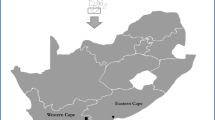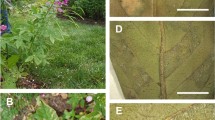Abstract
Species in the genus Basidiophora (Oomycota, Peronosporales) are pathogens causing downy mildew disease on several closely related plant hosts in the family Asteraceae, including the genera Conyza, Erigeron, Solidago, and Symphyotrichum. Despite their widespread occurrence, little is known about the diversity, biology, and economic impact of downy mildew pathogens of ornamental or wild plants in the Asteraceae. In June 2017, Solidago sphacelata plants of the cultivar ‘Golden Fleece’ were found in the state of Delaware, USA, showing typical symptoms of downy mildew disease. Initial morphological observations indicated the specimen belonged to the genus Basidiophora. Phylogenetic analysis of a sequence matrix of the partial cox2 mitochondrial gene using Bayesian and maximum likelihood methods showed that the Basidiophora isolate from S. sphacelata represents an undescribed species that is here described as B. delawarensis. This new species constitutes the third accepted species in the genus Basidiophora and can be distinguished from other Basidiophora species by differences in size of sporangia and sporangiophores and nucleotide sequence divergence. This new species poses a potential threat to its host, warranting close monitoring and the implementation of disease management programs.


Similar content being viewed by others
References
Barretto RW, Dick MW (1991) Monograph of Basidiophora (Oomycetes), with the description of a new species. Bot J Linn Soc 107:313–332
Burghardt KT, Tallamy DW, Shriver WG (2009) Impact of native plants on bird and butterfly biodiversity in suburban landscapes. Conserv Biol 23:219–224
Choi Y-J, Thines M (2015) Host jumps and radiation, not co-divergence drives diversification of obligate pathogens. A case study in downy mildews and Asteraceae. PLoS One 10:e0133655. https://doi.org/10.1371/journal.pone.0133655
Choi Y-J, Hong SB, Shin HD (2007) Re-consideration of Peronospora farinosa infecting Spinacia orleraceae as distinct species, Peronospora effusa. Mycol Res 111:381–391
Choi Y-J, Denchev CM, Shin HD (2008) Morphological and molecular analyses support the existence of host-specific Peronospora species infecting Chenopodium. Mycopathologia 165:155–164
Choi Y-J, Kiss L, Vajna L, Shin H-D (2009a) Characterization of a Plasmopara species on Ambrosia artemisiifolia, and notes on P. halstedii, based on morphology and multiple gene phylogenies. Mycol Res 113:1127–1136
Choi Y-J, Shin HD, Thines M (2009b) Two novel Peronospora species are associated with recent reports of downy mildew on sages. Mycol Res 113:1340–1350
Constantinescu O (1998) A revision of Basidiophora (Chromista, Peronosporales). Nova Hedwigia 66:251–265
Constantinescu O, Voglmayr H, Fatehi J, Thines M (2005) Plasmoverna gen. nov., and the taxonomy and nomenclature of Plasmopara (Chromista, Peronosporales). Taxon 54:813–821
Crandall SG, Rahman A, Quesada-Ocampo LM, Martin FN, Bilodeau GJ, Miles TD (2018) Advances in diagnostics of downy mildews: lessons learned from other oomycetes and future challenges. Plant Dis 102:265–275
Darriba D, Taboada GL, Doallo R, Posada D (2012) jModelTest 2: more models, new heuristics and parallel computing. Nat Methods 9:772
DuPont EN (1978) Landscaping with native plants in the middle Atlantic region. The Brandywine Conservancy, Inc, Chads Ford
Eom SH, Senesac AF, Tsontakis-Bradley I, Weston LA (2005) Evaluation of herbaceous perennials as weed suppressive groundcovers for use along roadsides or in landscapes. J Environ Hortic 23:198–203
Farr DF, Rossman AY (2018) Fungal databases, U.S. National Fungus Collections, ARS, USDA. Retrieved April 6, 2018 from https://nt.ars-grin.gov/fungaldatabases/
Göker M, Voglmayr H, Riethmüller A, Weiß M, Oberwinkler F (2003) Taxonomic aspects of Peronosporaceae inferred from Bayesian molecular phylogenetics. Can J Bot 81:672–683
Göker M, Voglmayr H, Riethmüller A, Oberwinkler F (2007) How do obligate parasites evolve? A multi-gene phylogenetic analysis of downy mildews. Fungal Genet Biol 44:105–122
Görg M, Ploch S, Kruse J, Kummer V, Runge F, Choi Y-J, Thines M (2017) Revision of Plasmopara (Oomycota, Peronosporales) parasitic to Impatiens. Mycol Prog 16:791–799
Gouy M, Guindon S, Gascuel O (2010) SeaView version 4: a multiplatform graphical user interface for sequence alignment and phylogenetic tree building. Mol Biol Evol 27:221–224
Hood JLA, Semple JC (2003) Pappus variation in Solidago (Asteraceae: Astereae). SIDA. Contrib Bot 20:1617–1630
Hudspeth DSS, Nadler SA, Hudspeth MES (2000) A COX2 molecular phylogeny of the Peronosporomycetes. Mycologia 94:674–684
Katoh K, Rozewicki J, Yamanda KD (2017) MAFFT online service: multiple sequence alignment, interactive sequence choice and visualization. Brief Bioinform:1–7
Kuraku S, Zmasek CM, Nishimura O, Katoh K (2013) aLeaves facilitates on-demand exploration of metaxoan gene family trees on MAFT sequence alignment server with enhanced interactivity. Nucleic Acids Res 41:22–28
Palti J, Cohen Y (1980) Downy mildew of cucurbtits (Pseudoperonospora cubensis): the fungus and its hosts, distribution, epidemiology and control. Phytoparasitica 8:109–147
Peck CH (1878) Report of the botanist. Ann Rep N Y State Mus Nat His 31:19–60
Petrželová I, Choi Y-J, Jemelková M, Doležalová I, Kruse J, Thines M, Kitner M (2016) Confirmation of Peronospora agrimoniae as a distinct species. Eur J Plant Pathol 147:887–896
Rambaut A (2014) FigTree v1.4.3. http://tree.bio.ed.ac.uk/software/figtree/
Rambaut A, Suchard M, Drummond A (2013) Tracer v1.6. http://tree.bio.ed.ac.uk/software/tracer/
Reuveni M (1998) Relationships between leaf age, peroxidase and beta-glucanase activity, and resistance to downy mildew in grapevines. J Phytopathol 146:525–530
Riethmüller A, Voglmayr H, Göker M, Weiß M, Oberwinkler F (2002) Phylogenetic relationships of the downy mildews (Peronosporales) and related groups based on nuclear large subunit ribosomal DNA sequences. Mycologia 94:834–849
Rivera Y, Salgado-Salazar C, Gulya T, Crouch JA (2016) Newly emerged populations of Plasmopara halstedii infecting rudbeckia exhibit unique genotypic profiles and are distinct from sunflower-infecting isolates. Phytopathology 106:752–761
Ronquist F, Teslenko M, van der Mark P, Ayres DL, Hohna S, Larget B, Liu L, Suchard MA, Huelsenbeck JP (2012) MrBayes 3.2: efficient Bayesian phylogenetic inference and model choice across a large model space. Syst Biol 61:539–542
Runge F, Ndambi B, Thines M (2012) Which morphological characteristics are most influenced by the host matrix in downy mildews? A case study in Pseudoperonospora cubensis. PLoS One 7:e44863
Salgado-Salazar C, LeBlanc N, Ismaiel A, Rivera Y, Warfield C, Crouch, JA (2018) Genetic variation of downy mildew on impatiens pre-dating and including 21st century epidemics on Impatiens walleriana. Plant Disease (in press) https://doi.org/10.1094/PDIS-01-18-0077-RE
Silvestro D, Michalak I (2012) raxmlGUI: a graphical front-end for RAxML. Org Divers Evol 12:335–337
Sökücü A, Thines M (2014) A molecular phylogeny of Basidiophora reveals several apparently host-specific lineages on Asteraceae. Mycol Prog 13:1137–1143
Stamatakis A (2006) RAxML-VI-HPC: maximum likelihood-based phylogenetic analyses with thousands of taxa and mixed models. Bioinformatics 22:2688–2690
Swingle WT (1891) In: Saccardo PA. Sylloge Fungorum 7:239
Thines M (2014) Validation of Basidiophora simplex. Schlechtendalia 28:39–40
Thines M, Choi YJ (2016) Evolution, diversity, and taxonomy of the Peronosporaceae, with focus on the genus Peronospora. Phytopathology 106:6–18
Thines M, Voglmayr H, Göker M (2009) Taxonomy and phylogeny of the downy mildews (Peronosporaceae). In: Lamour K, Kamoun S (eds) Oomycete genetics and genomics: diversity, interactions, and research tools. Wiley-VCH, Weinheim, pp 47–75
Thines M, Telle S, Choi YJ, Tan YP, Shivas RG (2015) Baobabopsis, a new genus of graminicolous downy mildews from tropical Australia, with an updated key to the genera of downy mildews. IMA Fungus 6:483–491
USDA, NRCS (2018) The PLANTS database (http://plants.usda.gov, 14 April 2018). National Plant Data Team, Greensboro
Voglmayr H, Constantinescu O (2008) Revision and reclassification of three Plasmopara species based on morphological and molecular phylogenetic data. Mycol Res 112:487–501
Voglmayr H, Göker M (2011) Morphology and phylogeny of Hyaloperonospora erophilae and H. praecox sp. nov., two downy mildew species co-occurring on Draba verna sensu lato. Mycol Prog 10:283–292
Voglmayr H, Thines M (2007) Phylogenetic relationships and nomenclature of Bremiella sphaerosperma (Chromista, Peronosporales). Mycotaxon 100:11–20
Voglmayr H, Riethmüller A, Göker M, Weiß M, Oberwinkler F (2004) Phylogenetic relationships of Plasmopara, Bremia and other genera of downy mildew pathogens with pyriform haustoria based on Bayesian analysis of partial LSU rDNA sequence data. Mycol Res 108:1011–1024
Voglmayr H, Fatehi J, Constantinescu O (2006) Revision of Plasmopara (Chromista, Peronosporales) parasitic on Geraniaceae. Mycol Res 110:633–645
Voglmayr H, Choi Y-J, Shin HD (2014a) Multigene phylogeny, taxonomy and reclassification of Hyaloperonospora on Cardamine. Mycol Prog 13:131–144
Voglmayr H, Montes-Borrego M, Landa BB (2014b) Disentangling Peronospora on Papaver. Phylogenetics, taxonomy, nomenclature and host range of downy mildew on opium poppy (Papaver somniferum) and related species. PLoS One 9:e96838
Wallace EC, Daughtrey ML, Crouch JA (2018) Downy mildew disease of New England aster caused by Basidiophora simplex in New York. Plant Dis (in press) https://doi.org/10.1094/PDIS-04-18-0555-PDN
Weaver S (2001) The biology of Canadian weeds. 115. Conyza canadensis. Can J Plant Sci 81:867–875
Wu BM, van Bruggen AHC, Subbarao KV, Pennings GGH (2001) Geospatial analysis of lettuce downy mildew using geostatistics and geographic information systems. Phytopathology 91:134–142
Yatskievych K (2000) Field guide to Indiana wildflowers. Indiana University Press, Bloomington
Yerkes WD, Shaw CB (1959) Taxonomy of the Peronospora species on Cruciferae and Chenopodiaceae. Phytopathology 49:499–507
Acknowledgements
This work was funded by the USDA-APHIS Farm Bill 10007 program, USDA-ARS project 8042-22000-298-00-D, and by the appointments of E. Wallace and C. Salgado-Salazar to the ARS Research Participation Program administered by the Oak Ridge Institute for Science and Education (ORISE) through an interagency agreement between the U.S. Department of Energy (DOE) and the USDA. ORISE is managed by ORAU under DOE contract number DEAC05-06OR23100. Mention of trade names or commercial products in this publication is solely for the purpose of providing specific information and does not imply recommendation or endorsement by the USDA. The USDA is an equal opportunity provider and employer.
Author information
Authors and Affiliations
Corresponding author
Additional information
Section Editor: Marco Thines
Rights and permissions
About this article
Cite this article
Wallace, E.C., Salgado-Salazar, C., Gregory, N.F. et al. Basidiophora delawarensis, a new downy mildew species infecting cultivated goldenrod (Solidago sphacelata) in the USA. Mycol Progress 17, 1283–1291 (2018). https://doi.org/10.1007/s11557-018-1444-z
Received:
Revised:
Accepted:
Published:
Issue Date:
DOI: https://doi.org/10.1007/s11557-018-1444-z




